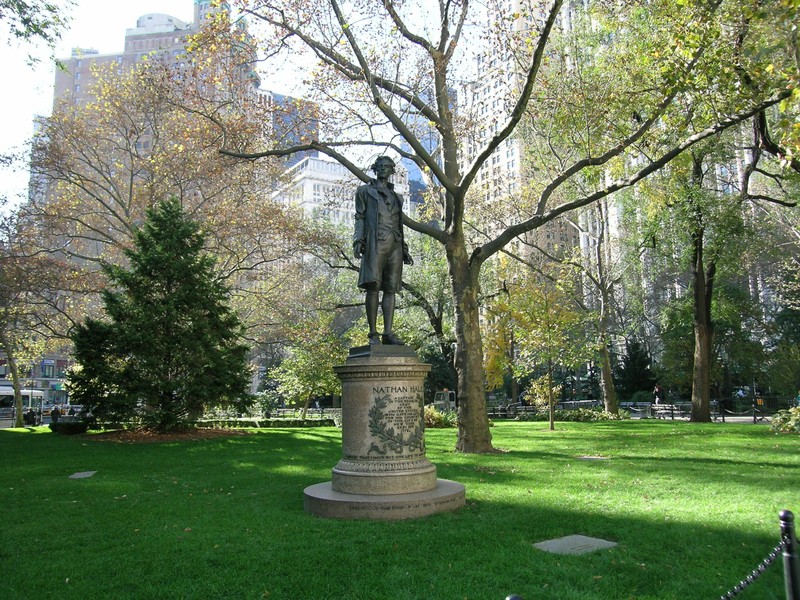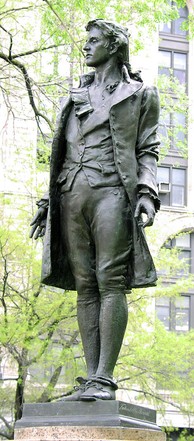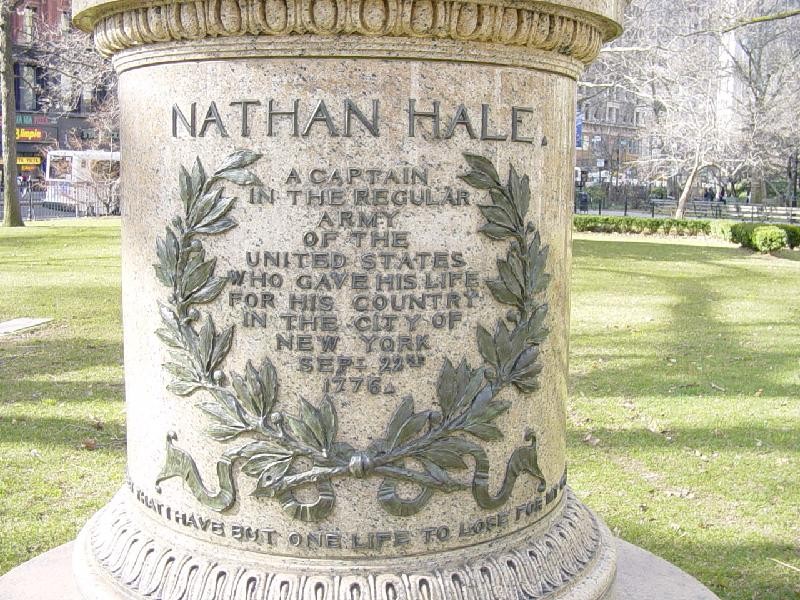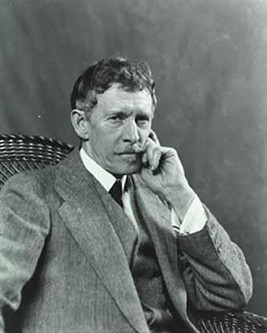Nathan Hale Statue
Introduction
Text-to-speech Audio
Images
Nathan Hale Statue in City Hall Park

A closer look at the bronze statue

A closer look at the granite pedestal

Frederick MacMonnies (1863-1937)

Backstory and Context
Text-to-speech Audio
Nathan Hale was born to a wealthy family in Coventry, Connecticut on June 6, 1755. At the age of fourteen, he enrolled at Yale College (now Yale University). An exemplary student, Hale graduated in 1773. That same year, he commenced a career in education, teaching first at a small school in East Haddam and then the following year at a private academy in New London.
In April 1775, the first shots of the American Revolution were fired at Lexington and Concord. The following month, two of Hale’s brothers marched to Massachusetts with the Connecticut Militia. Despite being enrolled in the Connecticut Militia, Hale remained behind to complete his teaching duties before traveling to Massachusetts a few weeks later to join his unit. That same year, he joined the Seventh Connecticut Regiment of the Continental Army, received a promotion to the rank of first lieutenant, and participated in the Siege of Boston. When his regiment’s enlistment term expired at the end of 1775, Hale joined the Nineteenth Connecticut Regiment and later received a promotion to the rank of captain.
Following their victory at the Battle of Brooklyn in late August 1776, the British completed the first step in their quest to capture New York City by taking control of Long Island. Camped across the East River in Manhattan was George Washington and the outnumbered Continental Army, with Hale in its ranks. Desirous to obtain information on his enemy’s next move, Washington created a battalion of rangers, whose purpose was to perform scouting and reconnaissance. The unit’s commander, Lieutenant Colonel Thomas Knowlton of Connecticut, selected Hale to serve with the rangers. Soon after, in early September, Washington asked for a volunteer from the battalion to sneak behind enemy lines on Long Island to gather intelligence on troop movements and fortifications. When the rest of his brothers-in-arms hesitated, Hale stepped forward and volunteered. He then left Manhattan and traveled to Norwalk, Connecticut. There, Hale secured passage across Long Island Sound. Dressed as a Dutch schoolteacher, he slipped behind British lines and collected information. On the evening of September 21, while Hale was attempting to sail across Long Island Sound and return to American-controlled territory, the British captured him. That night, British General William Howe interrogated Hale and, after being informed that incriminating documents had been found hidden under the soles of his shoes, sentenced him to death for spying. The next morning, the British hanged him. He was twenty-one years old. After leaving Hale’s body up for a few days as a warning to passersby, they buried it nearby. Legend has it that before his execution, Hale declared, “I only regret that I have but one life to lose for my country.” However, no evidence exists to support this claim.
Sometime around 1889 or 1890, the Sons of the Revolution in the State of New York sponsored a design competition for a statue of Hale the organization hoped to dedicate in Manhattan. Frederick MacMonnies, a twenty-six-year-old Brooklyn-born sculptor, won the competition and received the commission. MacMonnies’ work depicts an over-life-sized interpretation of Hale standing shackled and bound awaiting execution. Dedicated on November 25, 1893 (the one hundred and tenth anniversary of Evacuation Day), the bronze statue rests on a pink granite pedestal designed by architect Stanford White. Since its unveiling, the statue has been moved several times within City Hall Park. Most recently, in 1999, it was relocated from the edge of the park near the intersection of Broadway and Murray Street to the lawn in front of the entrance to City Hall, where it remains today.
Sources
Finlay, Nancy. "Nathan Hale: The Man and the Legend." ConnecticutHistory.org. CT Humanities. 6 June 2019. Web. 18 January 2021 <https://connecticuthistory.org/nathan-hale-the-man-and-the-legend/>.
History.com Editors. "Nathan Hale Volunteers to Spy Behind British Lines." History. A&E Television Networks. 10 September 2020. Web. 18 January 2021 <https://www.history.com/this-day-in-history/nathan-hale-volunteers-to-spy-behind-british-lines>.
"Nathan Hale." Encyclopædia Britannica. Web. 18 January 2021 <https://www.britannica.com/biography/Nathan-Hale>.
"Nathan Hale." New York City Department of Parks and Recreation. The City of New York. Web. 18 January 2021 <https://www.nycgovparks.org/parks/city-hall-park/monuments/654>.
Tucker, Spencer C., ed. American Revolution: The Definitive Encyclopedia and Document Collection. Santa Barbara, CA: ABC-CLIO, 2018.
https://www.pinterest.com/pin/241575967482620152/
https://diannedurantewriter.com/nathan-hale
https://www.nycgovparks.org/parks/city-hall-park/monuments/654
https://americanart.si.edu/artist/frederick-macmonnies-3059
